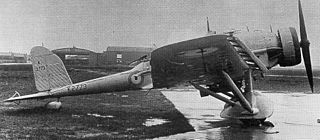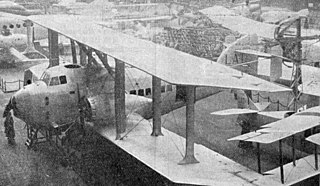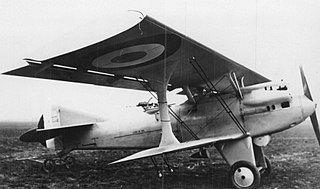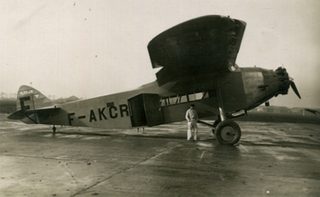Design and development
Though the Handley Page H.P.20 had demonstrated the efficacy of leading edge slots used in coordination with flaps in delaying the onset of stall at high angles of attack in 1921, [1] :213-4 they were only adopted slowly across Europe. The Handley Page Gugnunc of 1929 had two groups of slots, one which opened with the flaps and the other automatically opened by air pressure changes as the stall approached. [1] :281-2 The Bodiansky 20 was one of the first French aircraft to use this system. It was also the first French aircraft to have a welded steel tube fuselage structure, made in the factory of the aircraft constructor S. Poite. [2]

The Handley Page H.P.20 was an experimental monoplane modification of a de Havilland DH.9A, built to study controllable slots and slotted ailerons as high lift devices. It was the first aircraft to fly with controllable slots.

Flaps are a kind of high-lift device used to increase the lift of an aircraft wing at a given airspeed. Flaps are usually mounted on the wing trailing edges of a fixed-wing aircraft. Flaps are used for extra lift on takeoff. Flaps also cause an increase in drag in mid-flight, so they are retracted when not needed.

In fluid dynamics, angle of attack is the angle between a reference line on a body and the vector representing the relative motion between the body and the fluid through which it is moving. Angle of attack is the angle between the body's reference line and the oncoming flow. This article focuses on the most common application, the angle of attack of a wing or airfoil moving through air.
The cantilever wing of the Bodiansky 20 was built in three parts, with a short-span, thick, rectangular plan central section and nearly triangular plan outer panels which carried 8° of dihedral and thinned linearly outwards. The aspect ratio of the wing, 10.9, was high. Structurally the central section was a welded steel tube part of the fuselage and the outer panels were wooden, each with two spars and plywood skinned. Slats, which opened to form the slots, filled the whole leading edges of the outer panels and were divided into two sections. These sections matched the division of the trailing edge into ailerons outboard and flaps inboard. The outer slots opened automatically on the approach of the stall, whereas the inboard slats deployed when the flaps were lowered to their single down setting. [2]

A cantilever is a rigid structural element, such as a beam or a plate, anchored at one end to a support from which it protrudes; this connection could also be perpendicular to a flat, vertical surface such as a wall. Cantilevers can also be constructed with trusses or slabs. When subjected to a structural load, the cantilever carries the load to the support where it is forced against by a moment and shear stress.

Dihedral angle is the upward angle from horizontal of the wings or tailplane of a fixed-wing aircraft. "Anhedral angle" is the name given to negative dihedral angle, that is, when there is a downward angle from horizontal of the wings or tailplane of a fixed-wing aircraft.

In a fixed-wing aircraft, the spar is often the main structural member of the wing, running spanwise at right angles to the fuselage. The spar carries flight loads and the weight of the wings while on the ground. Other structural and forming members such as ribs may be attached to the spar or spars, with stressed skin construction also sharing the loads where it is used. There may be more than one spar in a wing or none at all. However, where a single spar carries the majority of the forces on it, it is known as the main spar.
It was powered by a nose-mounted, 75 kW (100 hp) Renault 4Pb, a four-cylinder, air-cooled, upright inline engine, though its mountings, part of the tubular fuselage structure, could accept engines with powers in the range 60–112 kW (80–150 hp). The exhaust was fitted with a silencer and its outlet was aft of the cabin. Fuel was held in two tanks in the wing centre-section and oil in the fuselage aft of the engine firewall. Its enclosed cabin, entered via centrally hinged, multi-part glazing, had two forward seats, equipped with dual controls, and a rear bench seat. It was normally flown from the left-hand seat, where the rudder bar was fitted with brake pedals. The flap lever was placed centrally. The fuselage was fabric covered apart from the engine area and the sloping fuselage roof and upper part aft of the cabin, which was covered with electron metal sheet. [2]

The straight or inline engine is an internal-combustion engine with all cylinders aligned in one row and having no offset. Usually found in four, six and eight cylinder configurations, they have been used in automobiles, locomotives and aircraft, although the term in-line has a broader meaning when applied to aircraft engines, see Inline engine (aviation).

Aircraft fabric covering is a term used for both the material used and the process of covering aircraft open structures. It is also used for reinforcing closed plywood structures, the de Havilland Mosquito being an example of this technique, and on the pioneering all-wood monocoque fuselages of certain World War I German aircraft like the LFG Roland C.II, in its wrapped Wickelrumpf plywood strip and fabric covering.
The tail of the Bodiansky 20 was conventional, with a small, triangular, in-flight adjustable tailplane mounted at the top of the fuselage frame. It carried generous, aerodynamically balanced elevators with a semi-elliptical trailing edge and was fitted with ground-adjustable trim tabs. The vertical tail was similar in profile and design to the horizontal surfaces; the rudder extended to the keel and worked in a deep elevator cut-out. Structurally these surfaces were steel tube framed and fabric covered. [2]

A tailplane, also known as a horizontal stabiliser, is a small lifting surface located on the tail (empennage) behind the main lifting surfaces of a fixed-wing aircraft as well as other non-fixed-wing aircraft such as helicopters and gyroplanes. Not all fixed-wing aircraft have tailplanes. Canards, tailless and flying wing aircraft have no separate tailplane, while in V-tail aircraft the vertical stabilizer, rudder, and the tail-plane and elevator are combined to form two diagonal surfaces in a V layout.

Balanced rudders are used by both ships and aircraft. Both may indicate a portion of the rudder surface ahead of the hinge, placed to lower the control loads needed to turn the rudder. For aircraft the method can also be applied to elevators and ailerons; all three aircraft control surfaces may also be mass balanced, chiefly to avoid aerodynamic flutter.

Elevators are flight control surfaces, usually at the rear of an aircraft, which control the aircraft's pitch, and therefore the angle of attack and the lift of the wing. The elevators are usually hinged to the tailplane or horizontal stabilizer. They may be the only pitch control surface present, sometimes located at the front of the aircraft or integrated into a rear "all-moving tailplane" also called a slab elevator or stabilator.
It had fixed tailwheel landing gear with a track of 2.4 m (7 ft 10 in). The mainwheels, equipped with brakes, were independently mounted on bent axles hinged from the central fuselage and restrained by drag struts from the forward lower fuselage frames. Each wheel had a short, vertical oleo strut from the forward part of the outer end of the wing centre-section. The tailwheel castored and was sprung and damped with rubber rings. [2]

Landing gear is the undercarriage of an aircraft or spacecraft and may be used for either takeoff or landing. For aircraft it is generally both. It was also formerly called alighting gear by some manufacturers, such as the Glenn L. Martin Company.

An oleo strut is a pneumatic air–oil hydraulic shock absorber used on the landing gear of most large aircraft and many smaller ones. This design cushions the impacts of landing and damps out vertical oscillations.
The Bodiansky 2 first flew on 6 July 1931. Only one, registered F-ALZB, [3] was built and its subsequent history in unknown. [4]
This page is based on this
Wikipedia article Text is available under the
CC BY-SA 4.0 license; additional terms may apply.
Images, videos and audio are available under their respective licenses.























